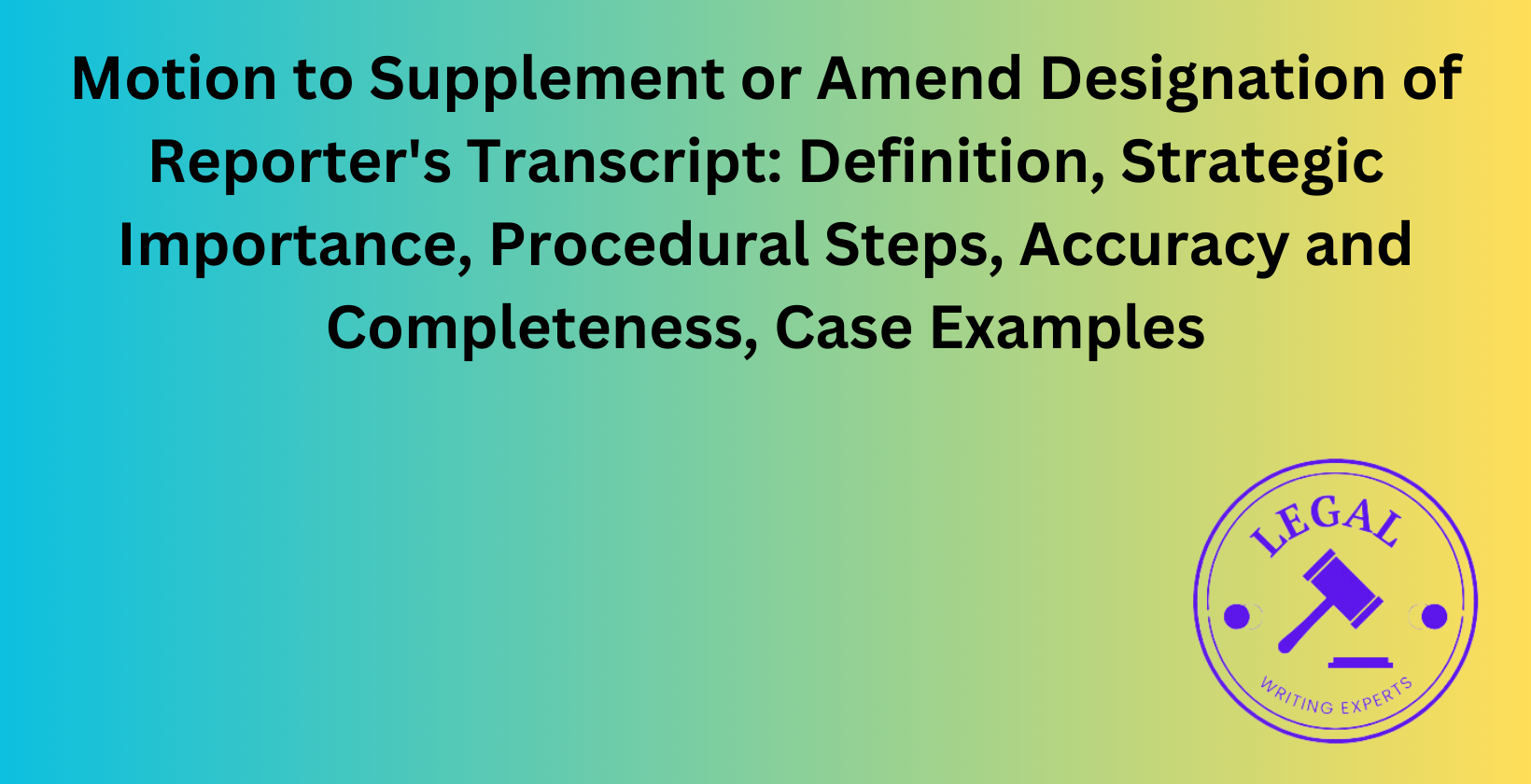Motion to Supplement or Amend Designation of Reporter’s Transcript
Written by
Jessica E
October 4, 2024 · 8 min read

A motion to supplement or amend designation of reporter’s transcript is a crucial legal procedure in the appeals process. This article explores the definition, strategic importance, procedural steps, and impact of such motions on appellate cases. We’ll examine how to write and file these motions, discuss their legal criteria, and provide case examples demonstrating their use. The article covers common mistakes, deadlines, limits on new evidence, and consequences of failing to include critical information. Understanding this process is essential for attorneys and parties involved in appeals to ensure a complete and accurate record for appellate review.
What Is a Motion to Supplement or Amend Designation of Reporter’s Transcript?
A motion to supplement or amend designation of reporter’s transcript is a formal request to the court to add or modify the portions of the trial record that will be included in the appeal. This motion allows parties to ensure that all relevant information from the lower court proceedings is available for review by the appellate court. It serves as a critical tool for appellants and appellees to address any omissions or errors in the initial designation of the record.
How to Write a Motion to Supplement or Amend Designation of Reporter’s Transcript?
Writing a motion to supplement or amend designation of reporter’s transcript requires careful attention to detail and adherence to court rules. The motion should clearly identify the specific portions of the transcript to be added or modified, explain the relevance of these additions to the issues on appeal, and provide a justification for why the amendment is necessary. It’s crucial to include a statement of the issues to be presented on appeal, as this helps demonstrate the importance of the requested additions or modifications.
Where to Hire a Legal Writer to Draft a Motion to Supplement or Amend the Reporter’s Transcript?
Legal writers experienced in appellate procedure can be hired through specialized Legal Writing Experts platform which is a freelance platform that caters to legal professionals. Legal Writing Experts maintain referral services that can connect attorneys with qualified legal writers. When selecting a writer, look for someone with specific experience in appellate motions and familiarity with the rules of the relevant appellate court.
How to File a Motion to Supplement or Amend Designation of Reporter’s Transcript?
Filing a motion to supplement or amend designation of reporter’s transcript typically involves submitting the motion to the appellate court clerk’s office. The motion must be served on all parties to the appeal. Some courts require electronic filing, while others may accept paper filings. It’s essential to check the specific rules of the appellate court regarding filing procedures, formatting requirements, and any associated fees.
What Are the Legal Criteria for Supplementing or Amending a Reporter’s Transcript?
The legal criteria for supplementing or amending a reporter’s transcript generally include demonstrating that the additional material is necessary for a complete review of the issues on appeal. Courts consider factors such as the relevance of the proposed additions, whether the material was part of the original trial record, and if the omission was due to inadvertence or excusable neglect. The moving party must show good cause for the amendment and explain why the material was not included in the original designation.
What Is the Strategic Importance of Supplementing or Amending the Transcript on Appeal?
The strategic importance of supplementing or amending the transcript on appeal cannot be overstated. A complete and accurate record is fundamental to a successful appeal. Supplementing the transcript ensures that all relevant evidence and arguments presented at trial are available for the appellate court’s review. This can be particularly crucial when key testimony or rulings were omitted from the original designation, potentially affecting the outcome of the appeal.
When Should You File a Motion to Amend or Supplement the Designation of the Reporter’s Transcript?
A motion to amend or supplement the designation of the reporter’s transcript should be filed as soon as the need for additional material is identified. Many jurisdictions impose strict deadlines for such motions, often within a certain number of days after the notice of appeal is filed or the original transcript is prepared. Filing promptly demonstrates diligence and increases the likelihood of the court granting the motion.
What Are the Procedural Steps for Filing a Motion to Supplement the Transcript?
The procedural steps for filing a motion to supplement the transcript typically include:
- Identifying the missing or incorrect portions of the transcript
- Drafting the motion with a clear explanation of the need for supplementation
- Attaching any necessary supporting documents
- Serving the motion on all parties to the appeal
- Filing the motion with the appropriate appellate court
- Paying any required filing fees
- Awaiting the court’s decision and complying with any orders issued
How Does Accuracy and Completeness of the Transcript Impact an Appeal?
The accuracy and completeness of the transcript significantly impact an appeal. An accurate and complete transcript provides the appellate court with a full picture of the proceedings below, enabling a thorough review of the issues raised on appeal. Inaccuracies or omissions can lead to misunderstandings of the trial court’s rulings or the evidence presented, potentially resulting in an unfavorable outcome. A comprehensive transcript supports the appellant’s arguments and allows the appellate court to make informed decisions.
What Happens If the Designation of the Transcript Is Incomplete or Incorrect?
The designation of the transcript is incomplete or incorrect, the appellate court may not have all the necessary information to properly review the case. This can lead to dismissal of certain arguments or even the entire appeal. In some cases, the court may order the parties to correct the record or may remand the case to the trial court for clarification. Incomplete or incorrect designations can result in delays, additional costs, and potentially adverse rulings based on an incomplete understanding of the case.
What Are Common Mistakes Made in Supplementing a Reporter’s Transcript?
Common mistakes made in supplementing a reporter’s transcript include:
- Missing filing deadlines
- Failing to clearly identify the specific portions of the transcript to be added
- Not providing a sufficient explanation for the need to supplement
- Requesting materials that were not part of the original trial record
- Overlooking relevant portions of the transcript
- Not serving all parties with the motion
- Failing to comply with court formatting and filing requirements
What Case Examples Demonstrate the Use of a Motion to Supplement or Amend a Transcript?
Case examples demonstrating the use of a motion to supplement or amend a transcript include:
- In Smith v. Jones, the appellant successfully moved to supplement the transcript with crucial expert testimony that was inadvertently omitted from the original designation.
- In a criminal appeal, the defense attorney filed a motion to amend the transcript to include sidebar discussions that were relevant to a key evidentiary ruling.
- In a complex civil case, both parties jointly moved to supplement the record with additional exhibits that were referenced during trial but not initially included in the transcript designation.
These examples illustrate how such motions can be used to ensure a complete record for appellate review.
How Do Courts Exercise Discretion in Approving a Motion to Supplement the Record?
Courts exercise discretion in approving a motion to supplement the record by considering several factors. They evaluate the relevance of the proposed additions to the issues on appeal, the timeliness of the motion, and whether the supplementation would cause undue delay or prejudice to the opposing party. Courts may balance the need for a complete record against the interests of judicial economy and finality. They may be more inclined to grant motions that address inadvertent omissions or newly discovered evidence that could not have been included in the original designation.
How to Oppose a Motion to Supplement or Amend the Designation of a Transcript?
Opposing a motion to supplement or amend the designation of a transcript involves filing a written opposition with the court. The opposition should argue why the proposed additions are unnecessary, irrelevant, or untimely. It may highlight any prejudice that would result from the supplementation or argue that the moving party had ample opportunity to include the material in the original designation. The opposition should be filed within the time frame specified by court rules and served on all parties.
What Are the Deadlines for Filing and Supplementing a Reporter’s Transcript on Appeal?
The deadlines for filing and supplementing a reporter’s transcript on appeal vary by jurisdiction. Typically, the initial designation of the record must be filed within a certain number of days after filing the notice of appeal, often 10 to 14 days. Motions to supplement are generally required to be filed promptly after discovering the need for additional material, with some courts setting specific deadlines, such as within 30 days of the original transcript filing. It’s crucial to consult the specific rules of the appellate court to ensure compliance with all deadlines.
What Are the Limits on Adding New Evidence Through Supplementation?
The limits on adding new evidence through supplementation are generally strict. Appellate courts typically restrict supplementation to materials that were part of the original trial record but were omitted from the initial transcript designation. New evidence that was not presented at trial is usually not allowed, except in rare circumstances involving newly discovered evidence that could not have been presented earlier. The focus is on completing the existing record rather than introducing new information.
What Are the Consequences of Failing to Include Critical Information in the Reporter’s Transcript?
Failing to include critical information in the reporter’s transcript can have severe consequences for an appeal. It may result in:
- The appellate court being unable to review certain arguments or issues
- Dismissal of specific claims or the entire appeal
- Affirmation of the lower court’s decision due to an incomplete record
- Waiver of arguments that rely on the omitted information
- Increased costs and delays if remand is necessary to supplement the record
- Potential malpractice claims against attorneys who failed to properly designate the record
How Do Appellate Courts Review a Motion to Supplement or Amend the Reporter’s Transcript?
Appellate courts review a motion to supplement or amend the reporter’s transcript by considering several factors. They examine the relevance of the proposed additions to the issues on appeal, the timeliness of the motion, and whether the supplementation is necessary for a fair review of the case. Courts may hold hearings or request additional briefing on the motion. They balance the need for a complete record against concerns of efficiency and finality. The decision to grant or deny such motions is typically within the court’s discretion, and rulings are made on a case-by-case basis.
Meet the Author
Distinguished linguist at Legal Writing Experts
Jessica is an expert legal writer with a remarkable blend of legal knowledge and linguistic precision. She earned her Juris Doctor degree from Duke University, where she attended on a prestigious Law Faculty Merit Scholarship. At Duke, Jessica demonstrated her exceptional abilities by serving as an editor of the Duke Law Review.
After graduating, Jessica further refined her skills during a two-year appellate clerkship at a distinguished law firm in North Carolina. Throughout law school, she enhanced her research and writing expertise as a research assistant and writer for various legal firms. Jessica’s deep understanding of legal language and meticulous attention to detail make her an invaluable asset to our legal writing services.


